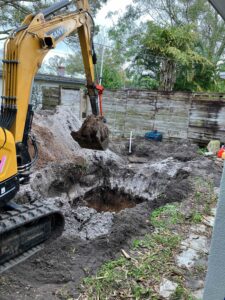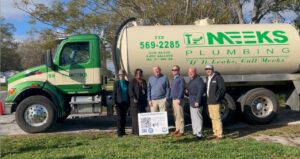Weekly Insights: Clean Water Coalition

Established in 2019, the Clean Water Coalition advocates as a unifying voice of our community partners for action by government and private entities to restore both surface and aquifer water resources of Indian River County for our common good. Recognizing a great need in the community, the Clean Water Coalition initiated a Septic to Sewer Conversion Project to help lower income households in the city currently using septic tanks to connect to sanitary sewer at a significantly reduced cost.
Fifty percent of the 55,000 households in Indian River County live either in poverty or one paycheck away from it, and at least one out of every four homeowners is housing cost burdened paying more than 30 percent of adjusted gross income for housing expenses. Currently, around 900 homes within Vero Beach city limits still rely on septic systems. Septic systems are major contributors to pollution, poor water quality, and marine ecosystem failure due to the high concentration of nitrogen they leach into the water.
While the Florida legislature has mandated changes by 2030 to address this issue, none of the homeowners who reside in the most impacted areas have sufficient financial resources to proactively pay for the $15,000 to $20,000 expense to convert their failing septic system to Vero Beach's municipal sewer system. These systems, particularly in our mainland communities where median household incomes are below $60,000, pose a financial and ecological burden. Under the Clean Water Coalition's initiative, homeowners will contribute approximately $5,500, spread over 10 years without interest, making it a feasible $550 annually.

The project is a result of a Public/Private collaboration among the City of Vero Beach, Indian River Land Trust, CWC, and Economic Opportunities Council. The project will encompass homes which are privately owned and occupied by low-income homeowners fronting Atlantic Boulevard, near the main relief canal which flows directly to the Indian River Lagoon.
As a result of this project, 75 septic to sewer connections will be completed, preventing at least 75 people from losing their homes. In addition, with each decommissioned septic tank, approximately 24 lbs./year of total nitrogen will be prevented from entering groundwater and the Indian River Lagoon, which together with phosphorus and fecal bacteria, could otherwise create an environmental disaster.
Additional funding to eventually convert 300 septic systems in Indian River County will continue to be pursued by the coalition. With more than 300,000 septic systems identified along multiple counties adjacent to the Indian River Lagoon, this project has the capacity to demonstrate a proven concept for other Florida communities to follow.